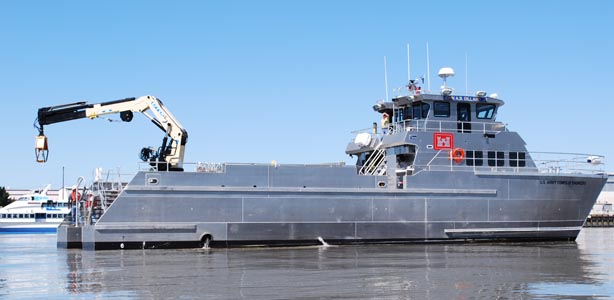Then a 50-foot tree is found floating in the Bay, just waiting to ruin someone’s day, it’s not a simple job to remove it. But thanks to the Army Corps of Engineers, there is a solution.
The crew onboard Dillard removes a large tree from the Bay. The attached crane can lift up to 15 tons. Photo by Kixon Meyer
By Joel Williams
Published: August, 2011
Then a 50-foot tree is found floating in the Bay, just waiting to ruin someone’s day, it’s not a simple job to remove it. But thanks to the Army Corps of Engineers, there is a solution.
If not removed, floating and partially submerged obstacles can cause catastrophic damage to ferryboats and other vessels traveling on the Bay. Bay Crossings was recently invited to ride along on the newly acquired Army Corps of Engineers derrick vessel John A.B. Dillard Jr.—named after Major General John A.B. Dillard (1919-1970), whose helicopter was shot down in Vietnam—to see firsthand this unique patrol, which has the primary mission of picking up debris.
We’re not talking about scooping up the small items of garbage that you may occasionally see floating around in the water; Dillard is equipped with a deck crane capable of lifting 15 tons. The main focus of Dillard is to search for what they call ferry killers, or large items that roll right through your screws and take ’em right on out, as Captain Kixon B. Meyer vividly describes.
One of the ferry killers that Captain Meyer is referring to is the dreaded deadhead—and he was not talking about the fans of the Grateful Dead. Deadheads are large wooden posts or trees that hang vertically in the water with only the top exposed. Sometimes these can be in excess of 40 feet long and, frequently, the other end has become embedded in the muddy floor of the Bay, leaving the deadhead poised to spear and completely destroy a vessel unfortunate enough to run into it head-on.
Ferry killers found in the Bay generally originate upstream from the Sacramento River. According to Captain Meyer, It’s really odd because typically this time of year we’re not getting much, but with all of the runoff we’re getting a lot of trees. Other similar hazards come from deteriorating pier pilings, which can be seen all around the Bay. In just the four hours that I tagged along with the five-man crew of the Dillard, we saw old dilapidated piers falling apart in Vallejo, Crockett and Richmond.
Dillard can travel at around 30 knots, which is a significant upgrade from its counterpart, the 1940s-era Raccoon, which only has a top speed of 8 knots. This allows Dillard to react much more quickly than previously possible. For instance, if Dillard is removing something from around the Mare Island Strait in Vallejo and it gets a call regarding a hazard in Alameda, it can be there in about an hour as opposed to almost four hours for Raccoon. Dillard also has offshore capabilities that Raccoon does not, allowing Dillard to operate outside the Gate. Raccoon still provides a much needed service though as it has a larger crane capacity and is needed to remove some obstacles like abandoned boats that Dillard cannot handle. Currently the territory assigned to Dillard runs from Crescent City down to Monterey as well as the entire Bay Area, Delta and areas of the Sacramento and San Joaquin Rivers.
When not going after a specific target that has been called in, Dillard is patrolling areas that are known to collect debris so it can be removed before drifting into areas where it can become a hazard to navigation. The average daily haul this year has been 3.7 tons, which indicates the surprising need for such a vessel to protect the waterways in the Bay.
The secondary mission of Dillard is as a command platform for emergency rapid response as well as for oil spill and pollution response. Dillard can also be called upon for initial on-scene search and rescue or dive and survey operations.
Individuals are encouraged to contact the Army Corps of Engineers at (415) 289-3000 to report large debris floating in the Bay. If you notice something during normal business hours, you can actually call Captain Meyer directly at (510) 590-8181 or VHF-FM Channel 16 on a shipboard radio. On weekends and evenings it is best to contact Coast Guard Sector San Francisco at (415) 399-3530 or VHF-FM Channel 16.
A “deadhead” is a large wooden post or tree that hangs vertically in the water with only the top exposed (left). Only after the crew worked this obstacle loose from the muddy bottom and removed it could the actual size of the hazard be seen (right). Photos by Kixon Meyer

Dillard is almost 90 feet long with a draft of 6 feet and a maximum speed of 30 knots. Photo by Joel Williams

